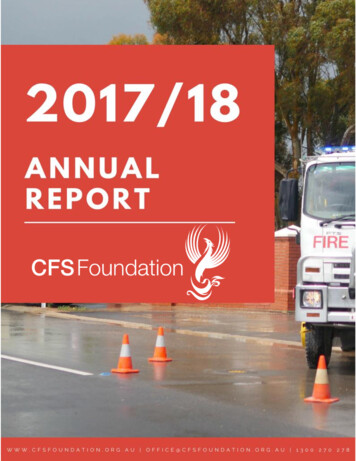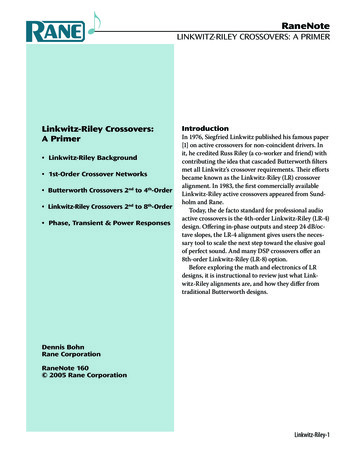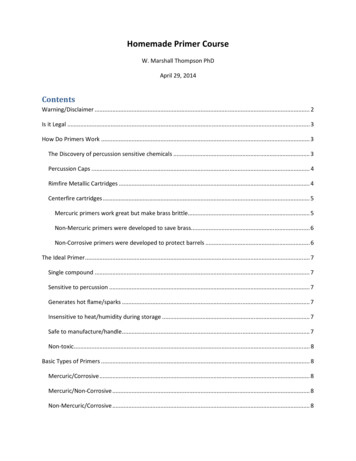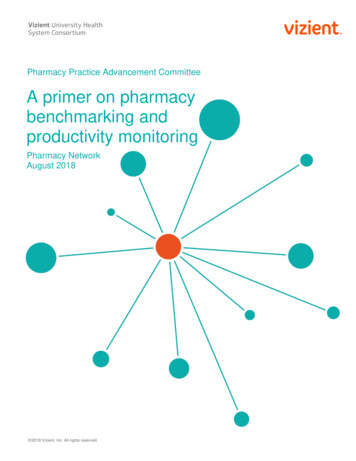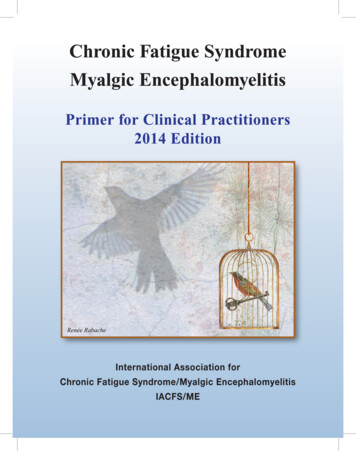
Transcription
ME/CFS: A Primer for Clinical PractitionersMembers of the IACFS/ME Primer Writing CommitteeFred Friedberg, Ph.D.ChairpersonStony Brook, New York, USALucinda Bateman, B.S., M.D.General Internal MedicineSalt Lake City, Utah, USALeonard A. Jason, Ph.D.Clinical-Community PsychologyChicago, Illinois, USAAlison C. Bested, M.D. F.R.C.P.C.Haematological PathologistVancouver, BC. CanadaCharles W. Lapp, M.D.Primary CareCharlotte, North Carolina, USATodd Davenport, D.P.T., O.C.S.Physical TherapyStockton, California, USAStaci R. Stevens, M.A.Exercise PhysiologyRipon, California, USAKenneth J. Friedman, Ph.D.Physiology/ Natural SciencesCastleton, Vermont, USARosemary A. Underhill, M.B., B.S.Physician, ResearcherPalm Coast, Florida, USAAlan Gurwitt, M.D.PsychiatryNewton Highlands, Massachusetts, USARosamund Vallings, M.B., B.S.Primary CareHowick, New ZealandAcknowledgementsWe gratefully acknowledge the generous support of Chase Community Giving and Hemispherx Biopharma inthe production of this primer. The primer committee also wishes to express its gratitude to: Lily Chu, M.D., Eulalia Benejam Cobb, Barbara B. Comerford Esq., Lucy Dechene, Ph.D., Pat Fero, Mary Ann Fletcher Ph.D., NancyG. Klimas, M.D., Susan M Levine, MD., Denise Lopez-Majano, The Massachusetts CFIDS/ME & FM Association,Lydia Neilson, James M. Oleske M.D., Ellen V. Piro, and Eleanor Stein, M.D. for their thoughtful reviews of anearlier draft of this primer. We also thank Renée Rabache for donating the cover art for this primer.Contact informationIACFS/ME, 27 N. Wacker Drive, Suite 416, Chicago, IL 60606 www.iacfsme.orgEmail: Admin@iacfsme.orgRevised July 20141
ME/CFS: A Primer for Clinical PractitionersConflicts of interest statementThe IACFS/ME received a 10,000 donation from Hemispherx, the maker of Ampligen (a possible treatmentfor ME/CFS), which supported this primer. Charles Lapp is a Hemispherx principal investigator in Ampligen studies and has a small amount of stock in the company. Lucinda Bateman has been a principal investigator inHemispherx Ampligen studies for 10 years. All other authors declared no conflicts of interest.DisclaimerThis primer was developed by consensus among members of the primer committee who have made considerable effort to ensure that the information is accurate and up to date. Statements, opinions and study resultspublished in this primer are those of the individual authors and the studies cited, and do not necessarily reflectthe policy or position of the IACFS/ME. The IACFS/ME provides no warranty, express or implied, as to the accuracy or reliability of all the contents of this primer. The recommendations contained in any part of this primerdo not indicate an exclusive course of treatment or course of action. Nothing contained in this primer shouldserve as a substitute for the medical judgment of a treating provider.2
ME/CFS: A Primer for Clinical PractitionersFOREWORDAbout 25 years ago, modern medicine began toseriously study the illness we now call ChronicFatigue Syndrome—also known as MyalgicEncephalomyelitis (ME/CFS).In the United States, the National Institutes ofHealth and the Centers for Disease Control andPrevention have conducted research in their laboratories and funded research elsewhere. TheInternational Association for CFS/ME (IACFS/ME)has organized eleven international conferences atwhich scientists from all over the world havepresented thousands of research studies.What has 25 years of research taught us? Twentyfive years ago we had no idea of the underlyingpathophysiology of this illness. Worse than that,we did not even know if there were any underlyingbiological abnormalities in the illness. Indeed,some clinicians and scientists argued that the illness was probably psychological, and some evenargued that it was a fabrication: patients wereimagining symptoms that had no physiologicalbasis.For those of us who are practicing physicians, thiswas a frustrating situation. We had little knowledge, and no proven tools, with which to try tohelp patients who came to our office.In my view, research of the past 25 years hasidentified many underlying biological abnormalitiesthat are present more often in patients withME/CFS than in healthy controls subjects or insubjects with other fatiguing illnesses, includingdepression, multiple sclerosis and Lyme disease.Neurological abnormalities. Brain imaging studieswith SPECT, PET and MRI have found abnormalitiesin both white and gray matter. Cognitive testinghas confirmed problems that are independent ofany coexisting psychological disorder. One grouphas reported a “signature” using EEG data thatdistinguishes patients with ME/CFS from patientswith depression and from healthy alities in several hypothalamic endocrinereleasing hormone axes, abnormalities that oftenare the opposite of what is seen in majordepression. Studies of spinal fluid proteins havefound unique patterns, and spinal fluidconcentrations of lactic acid (and, hence, pH) areabnormal. Finally, many studies have identifiedabnormalities of the autonomic nervous system inpatients with ME/CFS.Energy metabolism. A growing body of ial function are impaired in manypatients with ME/CFS. The basis for suchabnormalities remains undetermined, but chronicviral infection and chronic immune activation areboth proven causes of such abnormalities in otherdiseases.Infectious triggers. Many (but not all) patientsstate that their illness began suddenly, with aninfectious-like illness. There is good evidence thatME/CFS can follow in the wake of several differentviral and bacterial infections. Indeed, it seems unlikely that a single novel infectious agent will proveto be a cause of the great majority of cases. Also,there is evidence that several viruses that producelatent, life-long infection in many humans may bereawakened or reactivated in ME/CFS, although itis unclear if this is the cause or the effect of theillness.Immune activation. Many studies have foundevidence of chronic T cell activation. A recent studyof the drug rituximab provides indirect evidencefor chronic B cell activation, as well.Genetic component. Twin studies, studies of HLAantigens, and some gene sequencing studiesindicate that ME/CFS—like most illnesses—has anunderlying genetic component.Implications for practice. Despite the substantialprogress that has been made in understanding theunderlying biology of ME/CFS, we still don’t have asufficiently accurate diagnostic test, or a proventreatment. What we can tell patients is that:1) Research is uncovering what goes wrong in thebody; 2) Many laboratories are working ondeveloping diagnostic tests, and on testingtreatments suggested by our growing understanding of how ME/CFS affects the body.In this Primer, the collected wisdom of manyexperienced clinicians and clinician-scientists has3
ME/CFS: A Primer for Clinical Practitionersbeen gathered. Here, you’ll find advice on how todiagnose ME/CFS, and on therapies that appear tobe beneficial, although not curative. I think you willfind it useful.Anthony L. Komaroff, M.D.The Simcox-Clifford-Higby Professor of Medicine, Harvard Medical SchoolSenior Physician, Brigham & Women's Hospital4
ME/CFS: A Primer for Clinical PractitionersTable of ContentsPreface . . 61 Introduction and Overview . . . . 61:1 Nomenclature . . . 61:2 Epidemiology . . . 61:3 Diagnosis . . . . 71:4 Presentation and course of Illness . . 71:5 The health practitioners role indiagnosis and management . . . 72 Etiology . 82:1 Predisposing factors . . . 82:2 Precipitating and causal factors . . 83 Pathophysiology . . 83:1 Immune system abnormalities . . 83:2 Neuroendocrine dysregulation . . . 93:3 Brain abnormalities . . 103:4 Cognitive impairment . . . 103:5 Autonomic dysfunction/Cardiovascularabnormalities . . 103:6 Mitochondrial/energy productionabnormalities . . . . 103:7 Gene studies . . . . . 114 Clinical diagnosis . . . 114:1 Patient history . . 11Diagnostic worksheet . . 124:2 Physical examination . . 144:3 Laboratory tests . . 144:4 Differential diagnosis . . . . 144:5 Exclusionary medical conditions . . . 154:6 Co-existing medical conditions . 164:7 Differentiating between depressive/anxietydisorders and psychological reactionssecondary to ME/CFS . . . 165 Management/Treatment . . . 175:1 Approach to treatment . 185:2 Sleep . . 185:3 Pain . . 195:4 Fatigue and post-exertional malaise . . 20Activity and exercise . . . . 20Managing post-exertional symptoms,pacing and the energy envelope . . . 215:5 Cognitive problems . . . . 225:6 Managing depression, anxiety and distress 235:7 Cognitive behavioral therapy . 235:8 Management of related conditions . 24Orthostatic intolerance andcardiovascular symptoms . . 24Gastrointestinal problems . 24Urinary symptoms . . 24Allergies . 24Multiple chemical sensitivities . . . 24Infections and immunological factors . . 245:9 Dietary management . . . . 255:10 Alternative and complementaryapproaches . 265:11 Prognosis . . 265:12 Follow-up . . 276 Clinical concerns 276:1 Lowest functioning patients . 276:2 Pregnancy . . . . 286:3 Gynecological problems . . . . 296:4 Pediatric ME/CFS . . . 296:5 Immunizations . . . 306:6 Blood and tissue donation . . . 306:7 Recommendations prior to surgery . 307 References . . . . 31AppendicesA 1994 International research case definition(Fukuda et al) worksheet . 36B Pediatric case definition worksheet 37C Functional capacity scale . 38D Activity log . . 39E Recommendations prior to surgery . . 41F Fact sheet on ME/CFS . 43Index . . 455
ME/CFS: A Primer for Clinical PractitionersPREFACEThis primer has been written for the clinical practitioner. Our goal is to provide the information necessary tounderstand, diagnose, and manage the symptoms of chronic fatigue syndrome — also known as myalgic encephalomyelitis (ME/CFS). The text was developed by consensus of the primer committee. The authors havemade considerable efforts to ensure that the information provided is accurate and up to date. Since the extantliterature does not adequately describe the nature and treatment of this illness, this document is written as aprimer and is not “clinical practice guidelines” as recently redefined.* Where published studies are lacking, ourrecommendations are based on the clinical expertise of our experienced practitioners. Our hope is that youfind the primer to be a useful adjunct to your practice and a worthy companion to your reference library.Periodic updates will be available on our website: lusion-criteria.aspx1. INTRODUCTION & OVERVIEWThe terms chronic fatigue syndrome and myalgicencephalomyelitis (ME/CFS) describe a complexphysical illness characterized by debilitating fatigue, post-exertional malaise, pain, cognitive problems, sleep dysfunction and an array of other immune, neurological and autonomic symptoms.1The key feature of the syndrome, post-exertionalmalaise, is the exacerbation of symptoms followingminimal physical or mental activity, which can persist for hours, days or even weeks. Rest and sleepproduce only modest relief of fatigue and the othersymptoms. The illness is also characterized by substantially reduced physical and/or cognitive functioning.of chronic fatigue. Other less common names forthe illness are myalgic encephalopathy and chronicfatigue immune dysfunction syndrome (CFIDS). TheWorld Health Organization classifies myalgic encephalomyelitis as a disease of the central nervoussystem (G93.3.).3 A similar illness, post-viral fatiguesyndrome (PVFS), describes the lingering of fatiguesubsequent to a viral infection.Although ME/CFS is a physical illness, secondarypsychological symptoms may be present as inmany other chronic illnesses.The name ME is more commonly used in Europeand Canada, while the CFS term is more often usedin the USA and Australia. Different but overlappingcase definitions have been published for each ofthe two terms. Most research studies use “CFS”because a specific case definition (Fukuda et al.,19944) was written for this purpose. The acronymsME/CFS and CFS/ME are increasingly being usedworldwide.1:1 NomenclatureThe term myalgic encephalomyelitis (ME) wascoined in 1956 to describe a well-documented cluster outbreak of a fatiguing illness in London, England. The name chronic fatigue syndrome (CFS)was proposed following the investigation of a cluster outbreak of a similar fatiguing illness in Nevada(USA) in 1984. CFS replaced the preliminary name,chronic Epstein-Barr virus syndrome, because clinical studies were unable to confirm Epstein-Barrvirus as the putative cause. The name chronic fatigue syndrome has been criticized as being vagueand trivializing of the illness.2 CFS has also beenconfused with the common non-specific complaint1:2 EpidemiologyThe majority of patients present as sporadic or isolated cases, although cluster outbreaks of ME/CFShave occurred in many widely dispersed locations5including: Iceland (1948), London, England (1955),New Zealand (1984), and the USA (Nevada, 1984;New York State and North Carolina, 1985). The illness affects all ages, races and socioeconomicgroups. Onset usually occurs between the ages of30 and 50 years, but may occur at almost any age.It has been esti
ME/CFS can follow in the wake of several different viral and bacterial infections. Indeed, it seems un-likely that a single novel infectious agent will prove to be a cause of the great majority of cases. Also, there is evidence that several viruses that produce latent, life-long infection in many humans may be reawakened or reactivated in ME/CFS, although it is unclear if this is the cause or .
